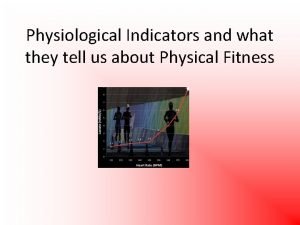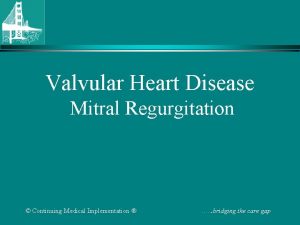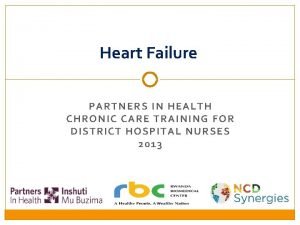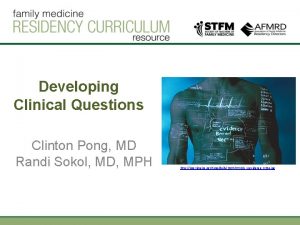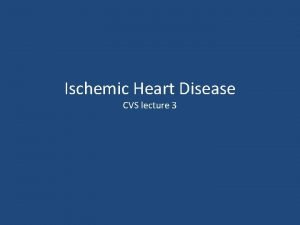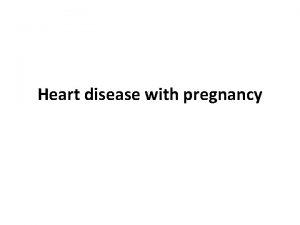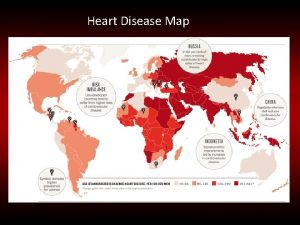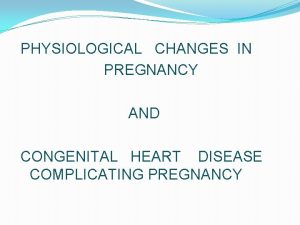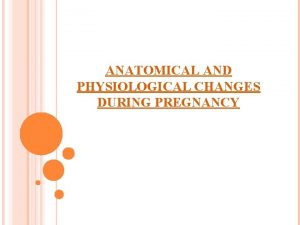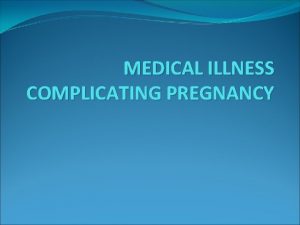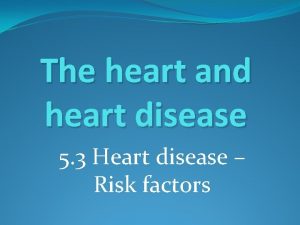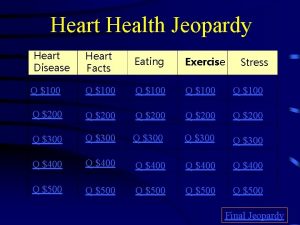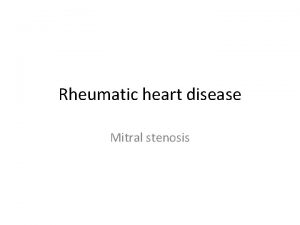pregnancy in Heart disease Physiological effects of pregnancy
















- Slides: 16

pregnancy in Heart disease ﺍﻳﻨﺎﺱ ﺍﻟﺨﻴﺎﻁ. ﺩ

Physiological effects of pregnancy on CVS : �- By 6 – 8 peripheral vasodilitation occur → » ↓ systemic vascular resistance �↑ Cardiac output(CO. ) by 20 %. �- ↑ CO. to about maximum of 40 % by 24 – 28 wks of gestation. � so ↑ risk of H. F. in this period. �- ↑ HR – 10 – 15 %. �- ↑ CO up to 80%above pre-labour values in first few hrs after delivery. �- CO. return to normal at 2 wks post delivery.

counselling of women with heart disease �Risk of maternal death. �Possible reduction of maternal life expectancy. �Effects of pregnancy on cardiac disease. �Mortality associated with high risk conditions. �Risk of fetus developing congenital heart disease. �Risk of preterm labour and FGR. �Need for frequent hospital attendance and possible admission. �Intensive maternal and fetal monitoring during labour. �Other options – contraception , adoption , surrogacy. �Timing of pregnancy.

Antenatal Management a joint obstetric / cardiac � History � Examination � Investigations � Follow up maternal &fetal well-being �

work heart Association ( NYHA ) classification � 1. Mild � No limitation of physical activity. Ordinary physical activity does not precipitate fatigue , palpitations , dyspnoea , angina. � 2. Mild � Slight limitation of physical activity. Comfortable at rest , but ordinary physical activity results in fatigue, palpitation or dyspnoea. � 3. Moderate � Marked limitation of Physical activity. Comfortable at rest , but less than ordinary activity causes fatigue , palpitation or dyspnoea. � 4. Severe � Unable to carry out any physical activity without discomfort. Symptoms of cardiac insufficiency at rest. If any physical activity is undertaken , discomfort is increased.

Toronta risk markers for maternal cardiac events Markers � 1 Prior episode of heart failure , arrhythmia or stroke. � 2 NYHA class > II or cyanosis. � 3 Left heart obstruction. � 4. Reduced left ventricular function ( EE < 40 per cent ) � 0 predictors : risk of cardiac event is 5 per cent ; I predictor : risk of cardiac event is 37 per cent ; > 1 predicators : risk of cardiac event is 75 per cent.

High-risk cardiac conditions �Systemic ventricular dysfunction ( ejection fraction < 30 per cent , NYHA class III – IV ). �Pulmonary hypertension �Cyanotic congenital heart disease. �Aortic pathology ( dilated aortic root > 4 cm , Marfan syndrome ). �Ischaemic heart disease. �Left heart obstructive lesions ( aortic , mitral stenosis ) �Prosthetic heart valves ( metal ). �Previous peripartum cardiomyopathy.

Fetal risks of maternal cardiac disease �Recurrence ( congenital heart disease ). �Maternal cyanosis ( fetal hypoxia ). �Iatrogenic prematurity. �FGR. �Effects of maternal drugs ( teratogenesis , growth restriction , fetal loss ).

Maternal risks: �-Endocarditis. �-Arrythmias. �- Paraxysmal embolic events. �-Heart failure &pulmonary hypertention. �- Death.

Risk factors for the development of heart failure �Respiratory or urinary infections. �Anaemia. �Obesity. �Corticosteroids. �Tocolytics. �Multiple gestation. �Hypertension. �Arrhymais. �Pain-related stress. �Fluid overload TREAT HEART FAILUR AS IN NON PREGNANT �

Management of labour and delivery �Management of labour in women with heart disease �Avoid induction of labour of possiblr. �Use prophylactic antibiotic. �Ensure fluid balance. �Avoid the supine position. �Discuss regional / epidural anaesthesia / analgesia with senior anaesthetist. �Keep the second stage short. �Use syntocinon judiciously.

Specific conditions Ischaemic heart disease � Mitral and aortic stenosis � Marfan syndrome � Pulmonary hypertension : � Peripartum cardiomyopathy ( CMP � Coarctation of Aorta � Prosthetic heart valves �

Strategies of anticoagulant regimen in pregnancy: �(1. ) Continue warfairn during pregnancy. ( or ) �(2. ) Replace warfarin with high dose heparin from 6 th – 12 th wks of gestation & 10 days before the delivery � (3. ) use high dose unfractionated or low molecular weight heparin throughout pregnancy.

Which option is chosen will depend on several factors: � 1. Type of mechanical valve : the risk of thrombosis is less with the newer bi-leaflet valves than first & 2 nd generation ball and cage valves. � 2. The position of the value replacement : Mitral position > risk Aortic position � 3. number of mechanical valves : Two valves give a high risk of thrombosis. � 4. The dose of warfarin required to maintain a therapeutic INR. � 5. Any previous history of embolic events.

according to risk of bacterial endocarditis : � - High-risk : Prosthetic valves , previous bacterial endocarditis , complex cyanotic congenital heart disease ( fallot's , transposition of great arteries , surgical systemic / pulmonary shunt ). acquired valvular disease. �Moderate risk : �Hypertrophic cardiomyopathy. Mitral value prolapse with mitral regurge. �

Stratification of cardiac conditions according to risk of bacterial endocarditis : �Negligible risk : �Secundum ASD. �Repaired ASD , VSD , PDA. �mitral prolapse with or without regurgitation. �Physiological Heart murmurs. �Pacemakers. � For high & moderate risk : �Endocarditis prophylaxis is recommended.
 Spotting differential diagnosis
Spotting differential diagnosis Working of smart bristow faradic coil
Working of smart bristow faradic coil Contraindications of irr
Contraindications of irr Diathermy frequency range
Diathermy frequency range Physiological effects of electricity
Physiological effects of electricity Physiological indicator
Physiological indicator Side effects of magnesium sulfate in pregnancy
Side effects of magnesium sulfate in pregnancy Communicable disease and non communicable disease
Communicable disease and non communicable disease Strepsore
Strepsore Cyanotic vs acyanotic
Cyanotic vs acyanotic Nursing assessment for congestive heart failure
Nursing assessment for congestive heart failure Mitral regurgitation symptoms
Mitral regurgitation symptoms Nyha classifications
Nyha classifications Site:slidetodoc.com
Site:slidetodoc.com Randi sokol
Randi sokol Rhumatic fever criteria
Rhumatic fever criteria Pathophysiology of ischemic heart disease
Pathophysiology of ischemic heart disease





